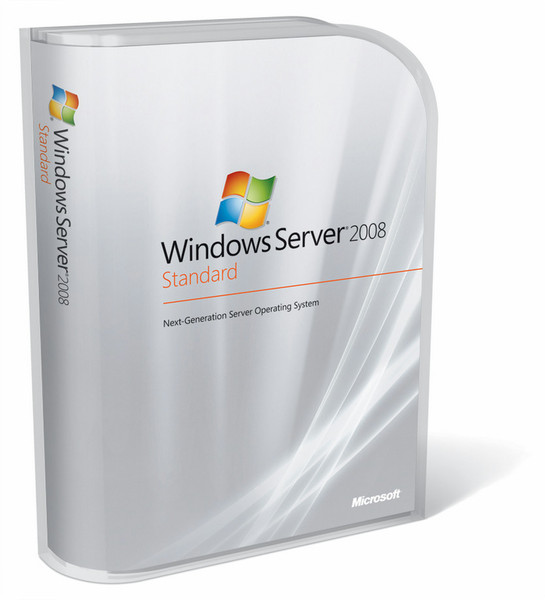目錄的
-
目錄的
- Antiquitäten & Kunst
- Auto & Motorrad: Fahrzeuge
- Baby
- Bücher
- Camping & Outdoor
- Feinschmecker
- Garten & Terrasse
- Haushalt & Wohnen
- Haustierbedarf
- Heimwerken & Garten
- IT和电子
- Kleidung & Accessoires
- Modellbau
- Musik
- PC- & Videospiele
- Sammeln & Seltenes
- Spielzeug
- TV, Video, DVD
- Telekommunikation
- Uhren & Schmuck
- Wellness & Beauty
- fashion & lifestyle
- institutional food services equipment
- medical equipment, accessories & supplies
- 个人护理
- 休闲爱好
- 办公设备,用品和配件
- 商业与工业
- 家居,建筑,装修
- 家用电器
- 摩托车及配件
- 武器和弹药
- 照相机
- 花园和庭院
- 运动,娱乐及休闲
- 食物
- 高保真音響
Filters
Search
Microsoft Windows Server 2008 R2 Standard, OLP NL
凡购买和价格 (Advertising *)
顶部
技术特点
顶部
系统要求
| 最小内存 (RAM) 要求 | 0.5 GB |
|---|---|
| 最小硬盘空间 | 32 GB |
其他功能
| 最低处理器 | 1.4 GHz |
|---|
Windows Server 2008 R2 Standard, OLP NL
Windows Server 2008 R2 builds on the award-winning foundation of Windows Server 2008, expanding existing technology and adding new features to enable IT professionals to increase the reliability and flexibility of their server infrastructures. New virtualization tools, Web resources, management enhancements, and exciting Windows 7 integration help save time, reduce costs, and provide a platform for a dynamic and efficiently managed data center. Powerful tools such as Internet Information Services (IIS) version 7.5, updated Server Manager and Hyper-V platforms and Windows PowerShell version 2.0 combine to give customers greater control, increased efficiency and the ability to react to front-line business needs faster than ever before.
Improving the Web Application Platform
Windows Server 2008 R2 includes many enhancements that make this release the most robust Windows Server Web application platform yet. It offers an updated Web server role, Internet Information Services (IIS) 7.5, and greater support for .NET on Server Core. Design goals for IIS 7.5 concentrated on improvements that enable Web administrators to more easily deploy and manage Web applications that increase both reliability and scalability. Additionally, IIS 7.5 has streamlined management capabilities and provides more ways to customize your Web serving environment. The following improvements to IIS and the Windows Web platform are included in Windows Server 2008 R2:
- Reduced Effort to Administer and Support Web-Based Applications
- Reduced Support and Troubleshooting Effort
- Improved File-Transfer Services
- Ability to Extend Functionality and Features
- Improved .NET Support
- Improved Application Pool Security
- IIS.NET Community Portal
<b>Enabling Server and Desktop Virtualization</b>
Virtualization is a major part of today’s data centers. The operating efficiencies offered by virtualization allow organizations to dramatically reduce operational effort and power consumption. Windows Server 2008 R2 provides the following virtualization types: Client and Server virtualization provided by Hyper-V and Presentation virtualization with Remote Desktop Services.
<b>Improving Power Management and Streamlining Management</b>
The ongoing management of servers in the data center is one of the most time-consuming tasks facing IT professionals today. Any management strategy you deploy must support the management of both your physical and virtual environments. To help with this problem, Windows Server 2008 R2 has new features to reduce the ongoing management of Windows Server 2008 R2 and to reduce the administrative effort for common day-to-day operational tasks.
<b>Scalability and Reliability</b>
Windows Server 2008 R2 is capable of unprecedented workload size, dynamic scalability, and across-the-board availability and reliability. A host of new and updated features will be available, including leveraging sophisticated CPU architectures, increased operating system componentization, and improved performance and scalability for applications and services.
Improving the Web Application Platform
Windows Server 2008 R2 includes many enhancements that make this release the most robust Windows Server Web application platform yet. It offers an updated Web server role, Internet Information Services (IIS) 7.5, and greater support for .NET on Server Core. Design goals for IIS 7.5 concentrated on improvements that enable Web administrators to more easily deploy and manage Web applications that increase both reliability and scalability. Additionally, IIS 7.5 has streamlined management capabilities and provides more ways to customize your Web serving environment. The following improvements to IIS and the Windows Web platform are included in Windows Server 2008 R2:
- Reduced Effort to Administer and Support Web-Based Applications
- Reduced Support and Troubleshooting Effort
- Improved File-Transfer Services
- Ability to Extend Functionality and Features
- Improved .NET Support
- Improved Application Pool Security
- IIS.NET Community Portal
<b>Enabling Server and Desktop Virtualization</b>
Virtualization is a major part of today’s data centers. The operating efficiencies offered by virtualization allow organizations to dramatically reduce operational effort and power consumption. Windows Server 2008 R2 provides the following virtualization types: Client and Server virtualization provided by Hyper-V and Presentation virtualization with Remote Desktop Services.
<b>Improving Power Management and Streamlining Management</b>
The ongoing management of servers in the data center is one of the most time-consuming tasks facing IT professionals today. Any management strategy you deploy must support the management of both your physical and virtual environments. To help with this problem, Windows Server 2008 R2 has new features to reduce the ongoing management of Windows Server 2008 R2 and to reduce the administrative effort for common day-to-day operational tasks.
<b>Scalability and Reliability</b>
Windows Server 2008 R2 is capable of unprecedented workload size, dynamic scalability, and across-the-board availability and reliability. A host of new and updated features will be available, including leveraging sophisticated CPU architectures, increased operating system componentization, and improved performance and scalability for applications and services.
-
支付方式
我们接受:











